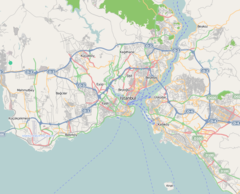Dolmabahçe Palace
| Dolmabahçe Palace | |
|---|---|

Dolmabahçe Palace as seen from the Bosphorus
|
|
| General information | |
| Type | Palace (1856–1922) |
| Architectural style | Baroque, Rococo, Neoclassical |
| Location | Istanbul, Turkey |
| Coordinates | 41°02′22″N 29°00′06″E / 41.03944°N 29.00167°ECoordinates: 41°02′22″N 29°00′06″E / 41.03944°N 29.00167°E |
| Construction started | 1843 |
| Completed | 1856 |
| Client | Ottoman sultans |
| Owner | Turkish state |
| Design and construction | |
| Architect | Garabet Balyan |
Dolmabahçe Palace (Turkish: Dolmabahçe Sarayı, IPA: [doɫmabahˈtʃe saɾaˈjɯ]) located in the Beşiktaş district of Istanbul, Turkey, on the European coastline of the Bosphorus strait, served as the main administrative center of the Ottoman Empire from 1856 to 1887 and 1909 to 1922 (with Yıldız Palace being used in the interim).
The site of Dolmabahçe was originally a bay on the Bosphorus which was used for the anchorage of the Ottoman fleet. The area was reclaimed gradually during the 18th century to become an imperial garden, much appreciated by the Ottoman sultans; it is from this garden that the name Dolmabahçe (Filled-in Garden) comes from the Turkish dolma meaning "filled" and bahçe meaning "garden." Various small summer palaces and wooden pavilions were built here during the 18th and 19th centuries ultimately forming a palace complex named Beşiktaş Waterfront Palace. The area of 110,000 m² is confined by Bosphorus on the east side, while a steep precipice bounds it on the west side, such that after the building of the new 45,000 m² monoblock Dolmabahçe Palace a relatively limited space has remained for a garden complex which would normally surround such a palace.
Dolmabahçe Palace was ordered by the Empire's 31st Sultan, Abdülmecid I, and built between the years 1843 and 1856. Previously, the Sultan and his family had lived at the Topkapı Palace, but as the medieval Topkapı was lacking in contemporary style, luxury, and comfort, as compared to the palaces of the European monarchs, Abdülmecid decided to build a new modern palace near the site of the former Beşiktaş Palace, which was demolished. Hacı Said Ağa was responsible for the construction works, while the project was realized by architects Garabet Balyan, his son Nigoğayos Balyan and Evanis Kalfa (members of the Armenian Balyan family of Ottoman court architects).
...
Wikipedia

